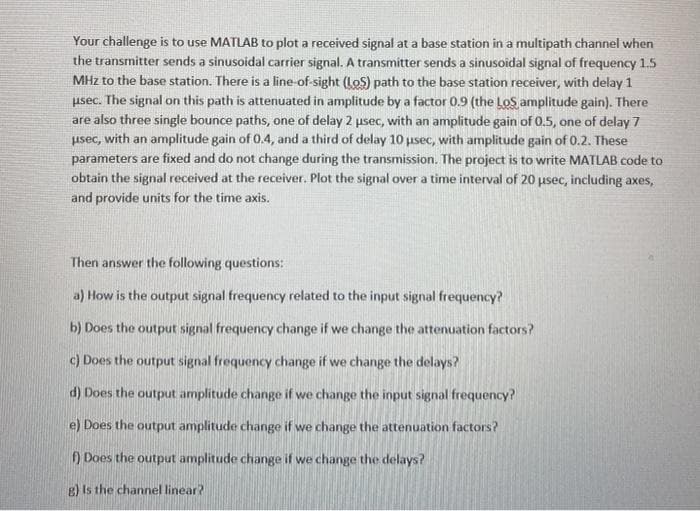Your challenge is to use MATLAB to plot a received signal at a base station in a multipath channel when the transmitter sends a sinusoidal carrier signal. A transmitter sends a sinusoidal signal of frequency 1.5 MHz to the base station. There is a line-of-sight (LoS) path to the base station receiver, with delay 1 usec. The signal on this path is attenuated in amplitude by a factor 0.9 (the LoS amplitude gain). There are also three single bounce paths, one of delay 2 usec, with an amplitude gain of 0.5, one of delay 7 usec, with an amplitude gain of 0.4, and a third of delay 10 usec, with amplitude gain of 0.2. These parameters are fixed and do not change during the transmission. The project is to write MATLAB code to obtain the signal received at the receiver. Plot the signal over a time interval of 20 usec, including axes, and provide units for the time axis. Then answer the following questions: a) How is the output signal frequency related to the input signal frequency?
Your challenge is to use MATLAB to plot a received signal at a base station in a multipath channel when the transmitter sends a sinusoidal carrier signal. A transmitter sends a sinusoidal signal of frequency 1.5 MHz to the base station. There is a line-of-sight (LoS) path to the base station receiver, with delay 1 usec. The signal on this path is attenuated in amplitude by a factor 0.9 (the LoS amplitude gain). There are also three single bounce paths, one of delay 2 usec, with an amplitude gain of 0.5, one of delay 7 usec, with an amplitude gain of 0.4, and a third of delay 10 usec, with amplitude gain of 0.2. These parameters are fixed and do not change during the transmission. The project is to write MATLAB code to obtain the signal received at the receiver. Plot the signal over a time interval of 20 usec, including axes, and provide units for the time axis. Then answer the following questions: a) How is the output signal frequency related to the input signal frequency?
Computer Networking: A Top-Down Approach (7th Edition)
7th Edition
ISBN:9780133594140
Author:James Kurose, Keith Ross
Publisher:James Kurose, Keith Ross
Chapter1: Computer Networks And The Internet
Section: Chapter Questions
Problem R1RQ: What is the difference between a host and an end system? List several different types of end...
Related questions
Question

Transcribed Image Text:Your challenge is to use MATLAB to plot a received signal at a base station in a multipath channel when
the transmitter sends a sinusoidal carrier signal. A transmitter sends a sinusoidal signal of frequency 1.5
MHz to the base station. There is a line-of-sight (LoS) path to the base station receiver, with delay 1
usec. The signal on this path is attenuated in amplitude by a factor 0.9 (the LoS amplitude gain). There
are also three single bounce paths, one of delay 2 usec, with an amplitude gain of 0.5, one of delay 7
usec, with an amplitude gain of 0.4, and a third of delay 10 usec, with amplitude gain of 0.2. These
parameters are fixed and do not change during the transmission. The project is to write MATLAB code to
obtain the signal received at the receiver. Plot the signal over a time interval of 20 usec, including axes,
and provide units for the time axis.
Then answer the following questions:
a) How is the output signal frequency related to the input signal frequency?
b) Does the output signal frequency change if we change the attenuation factors?
c) Does the output signal frequency change if we change the delays?
d) Does the output amplitude change if we change the input signal frequency?
e) Does the output amplitude change if we change the attenuation factors?
f) Does the output amplitude change if we change the delays?
B) Is the channel linear?
Expert Solution
This question has been solved!
Explore an expertly crafted, step-by-step solution for a thorough understanding of key concepts.
Step by step
Solved in 2 steps

Recommended textbooks for you

Computer Networking: A Top-Down Approach (7th Edi…
Computer Engineering
ISBN:
9780133594140
Author:
James Kurose, Keith Ross
Publisher:
PEARSON

Computer Organization and Design MIPS Edition, Fi…
Computer Engineering
ISBN:
9780124077263
Author:
David A. Patterson, John L. Hennessy
Publisher:
Elsevier Science

Network+ Guide to Networks (MindTap Course List)
Computer Engineering
ISBN:
9781337569330
Author:
Jill West, Tamara Dean, Jean Andrews
Publisher:
Cengage Learning

Computer Networking: A Top-Down Approach (7th Edi…
Computer Engineering
ISBN:
9780133594140
Author:
James Kurose, Keith Ross
Publisher:
PEARSON

Computer Organization and Design MIPS Edition, Fi…
Computer Engineering
ISBN:
9780124077263
Author:
David A. Patterson, John L. Hennessy
Publisher:
Elsevier Science

Network+ Guide to Networks (MindTap Course List)
Computer Engineering
ISBN:
9781337569330
Author:
Jill West, Tamara Dean, Jean Andrews
Publisher:
Cengage Learning

Concepts of Database Management
Computer Engineering
ISBN:
9781337093422
Author:
Joy L. Starks, Philip J. Pratt, Mary Z. Last
Publisher:
Cengage Learning

Prelude to Programming
Computer Engineering
ISBN:
9780133750423
Author:
VENIT, Stewart
Publisher:
Pearson Education

Sc Business Data Communications and Networking, T…
Computer Engineering
ISBN:
9781119368830
Author:
FITZGERALD
Publisher:
WILEY